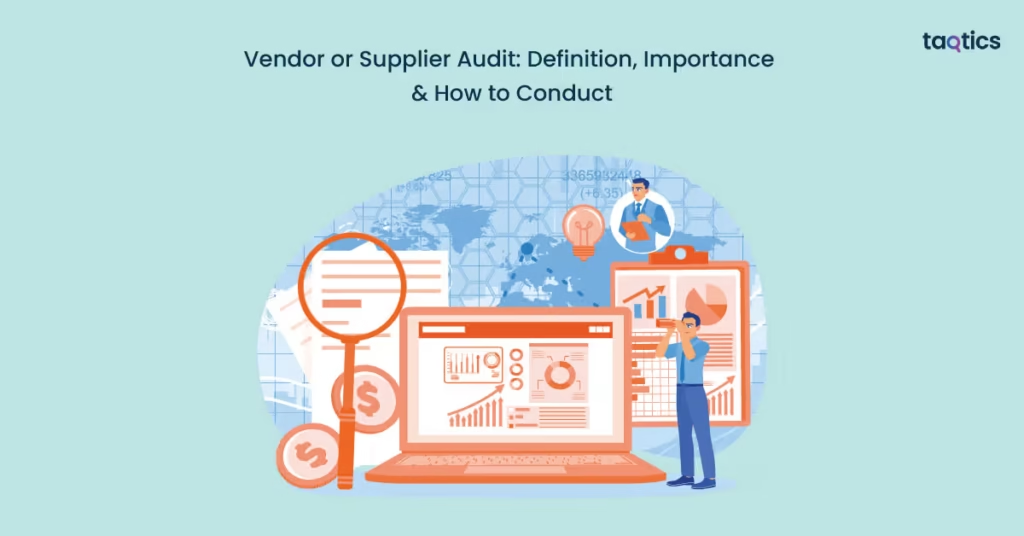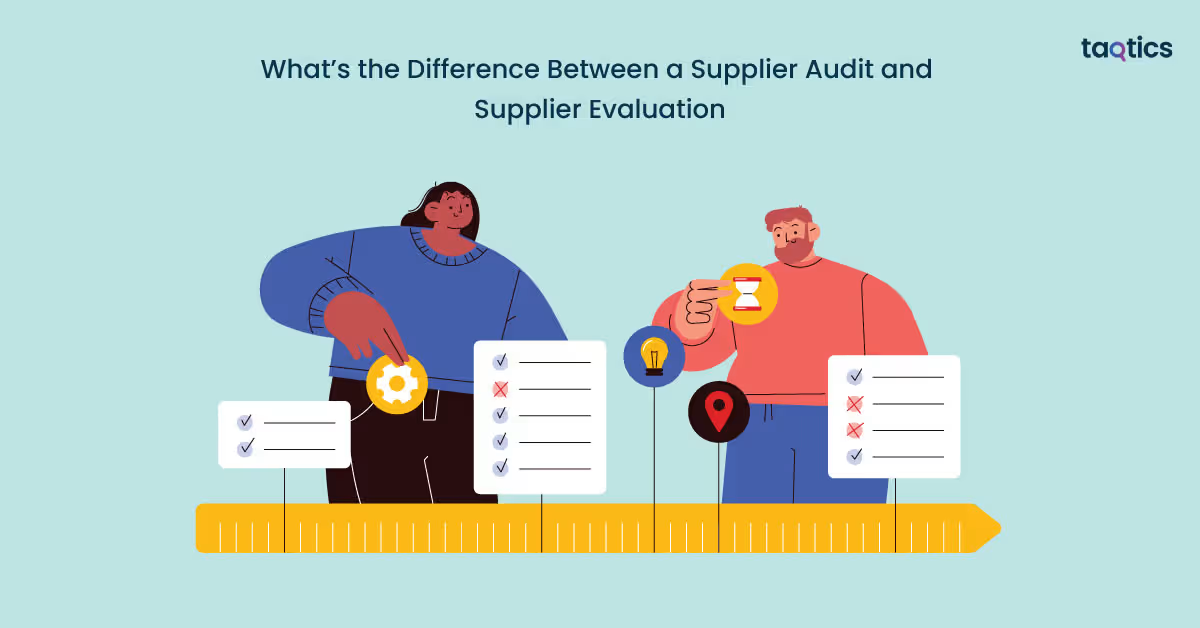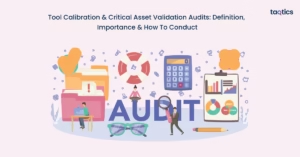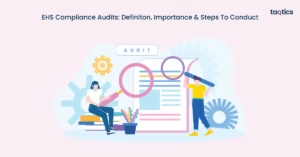Vendor or Supplier Audit: Definition, Importance & How to Conduct

A vendor or supplier audit is a systematic evaluation of a supplier’s processes, quality systems, and compliance with contractual or regulatory requirements. A vendor or supplier audit helps businesses ensure that their partners consistently deliver safe, high-quality products or services. Think of it like checking reviews and credentials before hiring a contractor to renovate your home. You verify their skills, past work, and reliability before trusting them with a critical task. Similarly, businesses conduct audits to reduce risk and confirm that suppliers meet agreed standards before integrating their products into the supply chain.
The importance of supplier audits is evident in their measurable impact on quality and cost control. According to a McKinsey & Company report (2021), supply chain disruptions cost companies an average of 42% of one year’s EBITDA over a decade, often due to vendor non-compliance or process failures. A Deloitte survey (2022) also found that 79% of companies that conduct regular supplier audits reported improved operational resilience and product quality. These audits are not just compliance exercises but a proactive strategy to safeguard brand reputation, maintain regulatory compliance, and ensure the reliability of the entire supply chain.
What Is a Vendor or Supplier Audit?
A vendor or supplier audit is a structured evaluation of a third-party’s facilities, processes, quality management systems, and regulatory compliance to ensure they meet a company’s standards. Vendors typically provide services or specialized solutions, while suppliers deliver raw materials, components, or finished products. Though these terms are often used interchangeably, suppliers are generally part of the production chain, whereas vendors may focus on delivering business services or tools. Audits ensure that both parties operate consistently, minimize risks, and meet legal or contractual obligations. According to PwC’s Global Supply Chain Survey (2022), 60% of organizations identified supplier quality issues as a major source of operational disruption, showing the need for regular assessments.
The key objectives of conducting these audits include verifying quality control systems, assessing regulatory compliance, and mitigating risks tied to product quality or service reliability. They also help organizations strengthen supplier relationships and identify opportunities for cost savings and performance improvements. A study by Gartner (2021) reported that companies with formalized supplier audit programs reduced supply chain risks by up to 30%. By focusing on these objectives, businesses can ensure that every link in their supply chain operates efficiently, meets industry standards, and supports long-term growth.
Why Are Vendor Audits Important?
Vendor audits are important because they ensure quality and compliance, reduce operational risks, build stronger relationships with suppliers, optimize costs, enhance customer satisfaction, and verify regulatory compliance.
- Ensuring Quality and Compliance: Vendor audits verify that suppliers meet quality benchmarks and certifications like ISO 9001. A Statista report (2022) found that companies with ISO-certified suppliers experienced a 20% reduction in product defects, underscoring the value of verified quality systems.
- Reducing Operational Risks: Early detection of supplier issues helps avoid disruptions. McKinsey (2021) reported that companies without robust supplier audits are twice as likely to face production delays during crises.
- Building Stronger Relationships with Suppliers: Audits done constructively encourage transparency and trust. Harvard Business Review (2020) noted that firms engaging in collaborative audits improved supplier performance by 23%.
- Cost Optimization: Identifying inefficiencies reduces costs from rework and defective goods. A Deloitte study (2021) showed that organizations with active supplier audit programs cut procurement costs by 15% annually.
- Customer Satisfaction: Reliable supplier quality directly affects end-user experience. According to PwC’s Consumer Insights Survey (2022), 73% of customers link brand trust to consistent product quality, highlighting the ripple effect of strong audits.
- Regulatory Compliance: Audits ensure suppliers comply with industry-specific regulations, reducing legal exposure. The U.S. FDA’s enforcement data (2021) revealed that 70% of warning letters cited supplier quality failures, showing the importance of audits in regulatory readiness.
Vendor audits are not just compliance measures but strategic tools to improve quality, lower risks, and strengthen supply chain performance, ultimately boosting brand reputation and customer trust.
What Are the Different Types of Vendor Audits?
The different types of vendor audits are compliance audits, ethical audits, announced audits, unannounced audits, and desktop audits.
- Quality Audits: These audits verify that products and processes consistently meet quality standards and specifications. According to the American Society for Quality (ASQ, 2021), organizations with regular quality audits see up to a 25% reduction in product defects, reinforcing their importance in production environments.
- Compliance Audits: Focus on adherence to regulatory frameworks like GMP, FDA, or ISO standards. A KPMG survey (2022) found that 64% of global companies view compliance audits as critical for avoiding costly penalties and recalls.
- Ethical Audits: Evaluate suppliers’ labor practices, environmental sustainability, and ethical sourcing. A PwC report (2022) noted that 76% of consumers prefer brands that conduct ethical audits, linking them to improved brand trust.
- Capability Audits: Assess whether a supplier has the operational capacity, infrastructure, and resources to meet future demands. Gartner (2021) reported that proactive capability audits improve supply chain resilience by 30%.
- Announced Audits: Planned in advance, these audits give suppliers time to prepare, making them ideal for assessing documentation and processes thoroughly.
- Unannounced Audits: Carried out without notice to observe real-time operations and detect hidden risks. A Deloitte study (2021) showed that unannounced audits uncover 20% more compliance issues than pre-scheduled visits.
- Desktop Audits: Remote audits conducted through documentation reviews and virtual evaluations. McKinsey (2020) found that desktop audits increased by 40% during the pandemic, providing cost-effective oversight.
Using a mix of these audit types enables companies to ensure supplier quality, strengthen compliance, and maintain ethical supply chains while adapting to evolving industry demands.
When Should You Conduct a Vendor Audit?
You should conduct vendor audits at critical points in the supplier relationship to ensure quality, compliance, and reliability.
- During Onboarding or Vendor Qualification: Audits conducted before a supplier is approved help verify capabilities, certifications, and compliance. According to a KPMG report (2021), 75% of organizations that audit vendors during onboarding reduce supplier-related risks by 30%.
- After Performance Issues or Complaints: If a vendor shows signs of poor quality, delays, or non-compliance, audits help uncover root causes and enforce corrective actions. A Deloitte study (2022) found that companies using targeted audits after performance issues improved supplier reliability by 28% within a year.
- On a Routine or Scheduled Basis (e.g., Annually): Regular audits ensure ongoing adherence to contracts, standards, and regulations. The Institute for Supply Management (ISM, 2020) reported that organizations with annual supplier audits experience 20% fewer supply chain disruptions compared to those with irregular audit schedules.
Vendor audits should be performed at onboarding, when issues arise, and on a recurring schedule to maintain a strong, compliant, and resilient supply chain.
How Do You Prepare for a Vendor Audit?
You can prepare for a vendor audit by organizing documentation, planning ahead, and coordinating closely with your supplier to ensure a smooth and efficient process. A well-structured approach minimizes surprises, reduces risks, and increases the likelihood of a successful audit outcome.
- Internal Checklist and Document Gathering: Start by compiling all relevant documentation, including supplier contracts, certifications, quality records, and previous audit findings. According to the Journal of Supply Chain Management (2021), companies that use structured audit checklists reduce preparation time by 35% and are more likely to meet regulatory expectations.
- Communication with the Supplier: Notify the vendor in advance and share the audit scope, expectations, and required documentation. A Harvard Business Review study (2020) found that transparent communication between auditors and vendors improves audit success rates by 25% by fostering cooperation and readiness.
- Pre-Audit Planning, Audit Plan, Defining Scope: Create a clear audit plan detailing timelines, team responsibilities, and key focus areas. Gartner (2022) reported that organizations with formalized audit plans experience 30% fewer non-conformities because teams know exactly what to evaluate and prioritize.
Proper preparation for a vendor audit involves detailed planning, strong supplier collaboration, and comprehensive documentation. This approach improves audit efficiency, strengthens relationships, and ensures a higher level of compliance.
What Are the Steps to Conducting Effective Vendor Audits?
The steps to conducting effective vendor audit include proper planning, open communication, thorough execution, and diligent follow-up to ensure long-term improvement. A well-structured audit process not only strengthens supplier performance but also reduces risks and enhances supply chain reliability.
- Define Audit Objectives: Clearly identify why the audit is being conducted, whether for compliance, quality assurance, or risk assessment. According to ISO 19011 guidelines (2021), audits with well-defined objectives improve overall effectiveness by 30%.
- Develop an Audit Checklist: Create a detailed checklist covering standards, certifications, and operational practices to ensure consistency. A Journal of Quality Assurance study (2020) reported that organizations using structured checklists reduce audit errors by 40%.
- Communicate with the Supplier: Share the audit plan, scope, and expectations with the vendor to build transparency and cooperation. A Deloitte report (2022) found that effective pre-audit communication reduces non-conformities by 18%.
- Conduct the On-Site Audit: Visit the facility, inspect processes, review records, and interview staff to gain a full understanding of operations. The Institute for Supply Management (ISM, 2021) observed that on-site audits identify 25% more risks compared to remote assessments.
- Analyze Findings and Provide Feedback: Summarize results and collaborate with vendors to address gaps through corrective actions. Gartner (2020) highlighted that companies implementing joint corrective action plans improve supplier performance by 22%.
- Monitor and Follow Up: Ensure agreed actions are executed and evaluate progress over time. A PwC study (2021) noted that regular follow-ups after audits reduce recurring issues by 28%, demonstrating the importance of this step.
Conducting effective vendor audits is about planning, transparency, and accountability. Following these structured steps ensures improved supplier performance, reduced risks, and stronger business relationships.
What Should Be Included in a Vendor Audit Checklist?
A vendor audit checklist should include quality system controls (QMS, ISO), document control, production controls, training and personnel qualifications, CAPA system, risk management, equipment maintenance and calibration, supplier control, and records and traceability.

Quality System Controls (QMS, ISO)
Verify that vendors follow robust quality management systems, such as ISO 9001. A Statista study (2022) showed that companies with certified QMS frameworks experienced a 20% improvement in process consistency.
Document Control
Ensure suppliers maintain accurate, updated policies, procedures, and records. Research from the Journal of Quality Management (2021) found that strong document control reduces audit non-conformities by 35%.
Production Controls
Review production planning, process validation, and quality assurance measures. According to ASQ (2020), companies with well-documented production controls reported 30% fewer product defects.
Training and Personnel Qualifications
Assess employee training programs and certifications. A 2021 SHRM report noted that organizations prioritizing staff training see a 24% increase in operational efficiency.
CAPA (Corrective and Preventive Action) System
Evaluate how effectively suppliers investigate and resolve issues. ISO 9001 emphasizes CAPA as a critical factor, with data from ISO.org (2021) showing CAPA implementation improves compliance rates by 27%.
Risk Management
Review risk assessment processes and mitigation strategies. PwC’s Risk Study (2022) revealed that businesses with strong risk management practices face 40% fewer supply chain disruptions.
Equipment Maintenance and Calibration
Ensure machinery is regularly serviced and calibrated. The NIST (2021) reported that equipment calibration reduces measurement errors, saving industries billions annually.
Supplier Control
Assess how vendors manage their own suppliers and subcontractors. A Gartner study (2020) highlighted that effective supplier oversight reduces secondary supply chain risks by 33%.
Records and Traceability
Verify systems for tracking raw materials, components, and finished products. The FDA (2021) found that strong traceability systems cut investigation time during recalls by 50%.
A comprehensive vendor audit checklist is vital for ensuring quality, safety, and regulatory adherence. By covering these elements, companies can identify risks early, strengthen partnerships, and maintain a reliable supply chain.
Who Conducts Vendor Audits?
Vendor audits are conducted by Internal audit teams, procurement or quality assurance professionals, and third-party auditors or audit firms. Each group plays a unique role in ensuring suppliers meet compliance, quality, and performance standards, helping organizations maintain a resilient and transparent supply chain.
Internal Audit Teams
These teams handle routine audits, focusing on company-specific requirements and internal policies. The Institute of Internal Auditors (IIA, 2021) reported that 68% of companies rely on internal audits to identify supplier-related risks early, demonstrating their critical role in ongoing quality oversight.
Procurement or Quality Assurance Professionals
These professionals evaluate suppliers’ ability to meet operational needs, quality standards, and contractual agreements. A Deloitte survey (2022) found that organizations with dedicated QA involvement in vendor audits reduce procurement-related quality issues by 32%.
Third-Party Auditors or Audit Firms
External auditors provide impartial evaluations and are often required for certifications like ISO or regulatory compliance checks. A KPMG report (2021) revealed that companies using third-party audits improve supplier compliance rates by 40%, thanks to their expertise and objectivity.
Vendor audits are best conducted through a mix of internal expertise, procurement oversight, and independent assessments. This combined approach ensures accurate evaluations, reduces compliance risks, and strengthens supplier partnerships.
What Qualifications Are Required?
The qualifications required to conduct vendor audits depend on whether the auditor is part of an internal team, a procurement or quality assurance department, or a third-party audit firm. Each role demands a mix of technical knowledge, certifications, and auditing experience to ensure thorough and credible evaluations.
- Internal Audit Teams: Internal auditors typically hold certifications like Certified Internal Auditor (CIA) or ISO 9001 Lead Auditor Certification. They should have strong knowledge of internal policies, supplier management systems, and industry regulations. According to the Institute of Internal Auditors (IIA, 2021), organizations with certified internal auditors achieve 25% higher audit accuracy.
- Procurement or Quality Assurance Professionals: QA and procurement professionals conducting audits should be trained in ISO standards, Good Manufacturing Practices (GMP), and supply chain risk management. Certifications like Certified Quality Auditor (CQA) from ASQ or Certified Supply Chain Professional (CSCP) add credibility. A Deloitte survey (2022) showed that companies with certified QA professionals reduced supplier quality issues by 32%.
- Third-Party Auditors or Audit Firms: Third-party auditors often require advanced credentials such as ISO/IEC 17021 or ISO/IEC 17025 Lead Auditor certifications and must have deep expertise in regulatory frameworks like FDA, OSHA, or GMP compliance. KPMG (2021) reported that audits performed by accredited external auditors improved supplier compliance rates by 40%.
Vendor auditors must possess formal certifications, regulatory expertise, and auditing experience. Certifications like ISO Lead Auditor, CQA, CIA, and CSCP ensure auditors have the technical and procedural knowledge to maintain quality and compliance across complex supply chains.
What Are Common Vendor Audit Findings?
The common vendor audit findings include missing or incomplete documentation, process deviations, expired certifications, and weak traceability systems. These issues, if left unaddressed, can lead to regulatory non-compliance, supply chain disruptions, or reputational damage.
Examples of Typical Issues
- Documentation Gaps: Missing SOPs, training records, or calibration certificates are frequent findings. A Journal of Quality Assurance study (2021) found that documentation errors contribute to 35% of supplier audit non-conformities.
- Process Deviations: Suppliers often fail to follow documented processes, leading to inconsistencies in production and quality.
- Expired Certifications: Outdated ISO or regulatory certifications raise compliance risks. PwC (2022) reported that companies with lapses in certification management experienced 22% more regulatory warnings.
- Inadequate Traceability: Poor batch or lot tracking slows investigations during recalls and increases liability.
- Insufficient CAPA Implementation: Corrective and Preventive Action systems are often poorly managed, limiting suppliers’ ability to resolve recurring issues effectively.
Severity Levels
- Major Findings: Significant gaps that pose high compliance or safety risks, such as missing regulatory certifications or repeated process deviations. These often require immediate corrective actions.
- Minor Findings: Lower-risk issues like isolated documentation errors or minor procedural inconsistencies, which are easier to resolve.
- Observations: Areas identified for improvement that are not yet non-compliant but could become risks if ignored. Gartner (2021) reported that organizations addressing audit observations early reduce future non-conformities by 28%.
Vendor audits frequently uncover documentation lapses, expired certifications, and process issues that can escalate into major risks. Categorizing findings by severity ensures companies focus resources on the most critical vulnerabilities first.
What Tools or Software Can Help With Supplier Audits?
The tools and software that can help with supplier audits are designed to streamline processes, improve accuracy, and ensure consistent compliance tracking. Leveraging audit management systems, like Taqtics, helps organizations reduce audit preparation time, minimize manual errors, and increase transparency across the supply chain.
Audit Management Systems
Audit management systems like MasterControl, MetricStream, and SAP Audit Management centralize supplier data, automate audit scheduling, and track findings. These systems allow auditors to conduct risk assessments, manage corrective actions, and generate reports easily. A MarketsandMarkets report (2022) found that the audit software market is expected to reach $2.9 billion by 2026, growing at 12.3% CAGR, reflecting its growing importance in compliance-driven industries.
Features to Look for in Audit Software
The features to look for in audit software are those that simplify audit preparation, improve traceability, and ensure smooth integration with existing systems. Choosing the right software can dramatically enhance efficiency and reduce compliance risks.
- Automated Reminders: Schedule calibration checks, audits, and follow-ups without manual tracking.
- Integrated Risk Assessment Tools: Identify and prioritize high-risk areas to focus audit efforts effectively.
- Real-Time Dashboards: Gain instant visibility into audit progress, compliance status, and key metrics.
- Offline Data Capture: Allow auditors to record findings on-site even without internet access, syncing data later.
- Advanced Analytics & Trend Identification: Detect recurring issues, process weaknesses, and long-term risk patterns.
- Seamless ERP/QMS Integration: Connect with enterprise systems for better data flow, accuracy, and reporting.
- Centralized Document Management: Store certificates, SOPs, and audit reports in one secure, searchable platform.
Robust audit software should streamline workflows, provide actionable insights, and integrate with existing systems. Deloitte (2021) found that organizations using integrated audit software improved efficiency by 33% and cut preparation time nearly in half, making it a critical investment.
Benefits of Automation and Digital Audit Trails
The benefits of automation and digital audit trails are numerous, helping organizations streamline audit processes, ensure compliance, and improve overall efficiency. These tools create transparency and consistency, making audits easier to manage and verify.
- Reduced Manual Workload: Automation eliminates repetitive paperwork, freeing teams to focus on high-value tasks.
- Lower Error Rates: Digital systems reduce the risk of human error, improving the accuracy of audit records.
- Regulatory Readiness: Automated audit trails provide verifiable, timestamped records, simplifying compliance audits.
- Faster Audit Cycles: A PwC survey (2022) found that automation reduced audit cycle times by 40%, accelerating reporting and approvals.
- Better Accountability: Digital logs create traceable records of who made changes and when, strengthening oversight.
- Improved Data Access: Centralized digital systems make documentation instantly accessible to auditors and teams.
- Cost Savings: Reducing manual work and delays lowers operational costs associated with compliance efforts.
Automation and digital audit trails enhance accuracy, transparency, and efficiency, making audits less burdensome while ensuring stronger regulatory compliance.
Supplier audit software and automation tools simplify processes, ensure compliance, and provide actionable insights. Whether remote or on-site, supplier audits are essential for businesses of all sizes to manage risks, meet regulations, and maintain quality.
What’s the Difference Between a Supplier Audit and Supplier Evaluation?
The difference between supplier audit and supplier evaluation lies in their focus and purpose within supplier management. A supplier audit is a structured, in-depth review of compliance, systems, and processes, while a supplier evaluation focuses on performance, cost-effectiveness, and reliability over time. Both methods complement each other to provide a comprehensive understanding of supplier quality and risk.

| Aspect | Supplier Audit | Supplier Evaluation |
| Definition | A formal inspection of supplier systems, documentation, and regulatory compliance. | A performance review that measures delivery, pricing, and service reliability. |
| Purpose | Ensures compliance, process integrity, and risk mitigation. | Focuses on supplier performance, cost-effectiveness, and long-term value. |
| Scope | Covers processes, QMS, certifications, traceability, and regulatory standards. | Covers KPIs, scorecards, pricing trends, lead times, and customer service performance. |
| Method | Conducted through on-site or remote audits, documentation review, and inspections. | Conducted via data analysis, performance metrics, and scorecards. |
| Frequency | Scheduled periodically (annually or bi-annually) or triggered by compliance needs. | Performed quarterly, annually, or continuously using supplier data and feedback. |
| Outcome | Generates formal audit reports and corrective action requests (CARs). | Results in ratings or rankings for supplier selection and retention decisions. |
| When Used | Required in regulated industries or when validating supplier processes and systems. | Used to compare, monitor, and evaluate suppliers’ overall performance. |
| Key Benefit | Strengthens compliance assurance and process reliability. | Supports strategic sourcing and supplier relationship management. |
| Example | Checking if a supplier’s plant meets ISO 9001 or FDA standards. | Rating suppliers based on on-time delivery and pricing trends. |
Audits provide a deep dive into compliance and system integrity, while evaluations offer ongoing visibility into supplier performance. McKinsey (2021) found that companies using both approaches reduced supplier risk exposure by 35%, proving that a combined strategy delivers a stronger, more resilient supply chain.
Are Remote Supplier Audits Effective?
Yes, remote supplier audits can be highly effective when using video inspections, cloud-based documentation sharing, and digital audit tools. These became essential during the pandemic, with McKinsey (2021) reporting a 45% increase in remote audits, which helped companies maintain oversight without travel costs. However, they may be best suited for lower-risk suppliers, while critical vendors still benefit from on-site inspections.
Can Small Businesses or Startups Perform Supplier Audits?
Yes, small businesses and startups can perform supplier audits by starting with simplified checklists, standardized templates, and affordable audit tools. A QuickBooks survey (2022) found that 68% of small businesses performing basic supplier audits improved supplier performance within a year, proving that even simple audits deliver strong ROI without large budgets.
What Happens If a Supplier Fails an Audit?
When a supplier fails an audit, companies typically issue Corrective Action Requests (CARs), implement remediation timelines, and may temporarily suspend or terminate contracts if issues persist. According to the Institute for Supply Management (ISM, 2021), over 70% of suppliers fail an initial audit pass after implementing corrective measures within six months, showing the importance of collaboration rather than immediate disengagement.
How Frequently Should Supplier Audits Be Conducted?
Supplier audit frequency depends on risk level, regulatory requirements, and supplier performance history. Critical vendors may require annual or bi-annual audits, while low-risk suppliers can be audited every 2-3 years. A KPMG report (2021) highlighted that companies auditing high-risk suppliers annually reduced supply chain disruptions by 28%, proving that tailored schedules maximize efficiency and safety.
Are There Any Legal or Regulatory Requirements for Supplier Audits?
Yes, industries like pharmaceuticals, aerospace, and food manufacturing often mandate supplier audits to meet FDA, ISO, or GMP regulations. Failure to comply can lead to severe penalties. The FDA (2021) issued over 4,600 warning letters for quality and supplier oversight failures, underscoring the legal importance of regular supplier audits.



